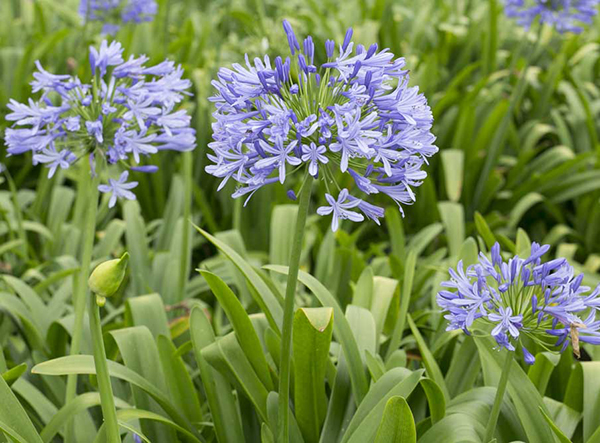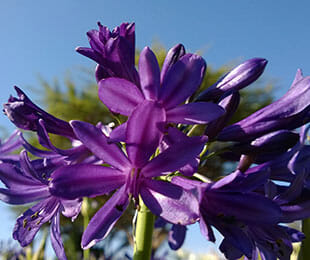Releasing the Secret to Effective Agapanthus Growing: Advice for a Flourishing Yard
In the realm of gardening, cultivating agapanthus successfully calls for a strategic strategy that includes numerous elements of plant care. With cautious focus to detail, one can unlock the tricks to supporting these magnificent blooms, resulting in a yard that grows with elegance and vibrancy. By recognizing the subtleties of agapanthus farming, one can develop an atmosphere where these plants grow and flower perfectly. In the complying with conversation, we will discover important pointers and tricks that will guide you towards a prospering agapanthus garden, supplying insights into best methods, soil problems, sprinkling techniques, and a lot more.
Planting Agapanthus: Ideal Practices
When planting Agapanthus, appropriate soil prep work is essential for making certain successful development and growth of these beautiful blossoms. Agapanthus, generally called Lily of the Nile or African lily, prospers in well-draining soil with a somewhat acidic to neutral pH level - Agapanthus. Prior to planting, it is vital to amend heavy clay soils with raw material such as garden compost or peat moss to boost water drainage and supply necessary nutrients for the plants
To grow Agapanthus, choose a place that gets full sunlight to partial shade, as this will certainly promote healthy and balanced development and bountiful flowering. Dig a hole two times the diameter of the plant's root round and position the Agapanthus at the very same deepness it was formerly expanding. Gently backfill the hole with dirt, weighing down firmly to get rid of any air pockets around the origins.
Water the recently planted Agapanthus thoroughly and remain to keep the soil evenly damp, particularly throughout the plant's active growing period. Agapanthus. Using a balanced fertilizer once a month can even more sustain the plant's development and flowering. By adhering to these finest methods for planting Agapanthus, you can create a sensational screen of these exciting flowers in your yard
Suitable Soil Conditions for Agapanthus
For ideal development and growing success of Agapanthus plants, guaranteeing the dirt problems are excellent is essential. Agapanthus chooses soil that is abundant in nutrients, so including a well balanced plant food throughout the growing season can promote healthy and balanced development and vibrant blooms.

Watering and Feeding Tips
To guarantee healthy and balanced development and lively blooms, correct watering and fertilizing strategies are crucial for successful Agapanthus farming. Agapanthus plants profit from normal watering, especially throughout the expanding period. It is advised to water deeply once a week, making certain the soil is wet however not waterlogged. During heat or in pots, even more regular watering might be required to stop the dirt from drying completely.
When it involves feeding Agapanthus, a well balanced fertilizer with equivalent parts nitrogen, phosphorus, and potassium can be applied in the spring to promote healthy growth and blooming. Slow-release plant foods are perfect for supplying nutrients progressively over an extended period. Avoid over-fertilizing, as this can result in extreme vegetation development at the cost of flowers.
Furthermore, integrating organic matter like compost right into the dirt can boost nutrient degrees and boost soil framework, index helping in the general wellness of the Agapanthus plants. By complying with these watering and feeding ideas, garden enthusiasts can ensure their Agapanthus plants prosper and produce magnificent display screens of flowers.
Pruning and Deadheading Techniques
Appropriate trimming and deadheading strategies play an important function in maintaining the wellness and appearances of Agapanthus plants, enhancing the essential techniques of watering and fertilizing for successful cultivation. Pruning Agapanthus involves getting rid of spent blossom heads, dead or yellowing leaves, and total shaping of the plant to promote far better development. Deadheading, the procedure of eliminating discolored flowers, not only boosts the plant's appearance but also urges further blooming.
When deadheading Agapanthus, it is a good idea to click reference snip off the flower stem at the base using sharp, tidy shears. This process reroutes the plant's energy from seed manufacturing back into root and foliage development, advertising a healthier and much more robust plant. Routine deadheading can extend the flowering duration of Agapanthus and prevent self-seeding, which can bring about congestion.
In regards to pruning, Agapanthus typically benefits from a light trim after blooming to clean the plant and motivate fresh growth. Reducing back the spent flower stems and removing any damaged or dead foliage aids maintain the plant's vigor and overall look. However, it is necessary to stay clear of cutting into the crown of the plant, as this can compromise its health and wellness.

Protecting Agapanthus From Vermins and Diseases
Executing efficient pest and condition monitoring methods is crucial to securing the wellness and vitality of Agapanthus plants in growing. Agapanthus are usually hardy plants, yet they can still come down with different parasites and illness otherwise effectively looked after. One common pest that affects Agapanthus is the Agapanthus borer, a caterpillar that passages right into the plant, causing damages to the leaves and flowers. To stop infestations, regular assessment of the plants is essential. If borers are detected, they can be manually eliminated, or insecticidal soap can be made use of as a control step.
Along with bugs, Agapanthus are susceptible to diseases such as origin rot and fungal leaf areas. These problems can usually be avoided by guaranteeing correct water drainage and preventing overwatering. If signs of condition show up, affected parts of the plant should be immediately removed to stop more spread. Fungicides might likewise be made use of as a treatment step, adhering to the maker's directions very carefully. By staying cautious and addressing bug and illness problems immediately, garden enthusiasts can aid their Agapanthus thrive and prosper.

Final Thought
In final thought, successful growing of agapanthus calls for appropriate planting strategies, suitable soil conditions, sufficient watering and feeding, normal trimming and deadheading, and protection from illness and bugs. By complying with these methods and tips, gardeners can make sure a flourishing garden full of beautiful agapanthus blossoms. Agapanthus. Keep in mind to maintain constant care and attention to information to advertise the health and wellness and durability of these spectacular plants
When growing Agapanthus, correct dirt preparation is essential for guaranteeing effective growth and growth of these stunning about his flowers.Water the recently planted Agapanthus completely and continue to maintain the soil equally wet, specifically during the plant's energetic expanding period.For ideal development and growing success of Agapanthus plants, making sure the soil conditions are excellent is crucial. When hair transplanting or growing Agapanthus, make sure the soil is well-prepared to supply the essential foundation for the plants to establish themselves efficiently. One typical bug that affects Agapanthus is the Agapanthus borer, a caterpillar that tunnels right into the plant, triggering damage to the blossoms and fallen leaves.